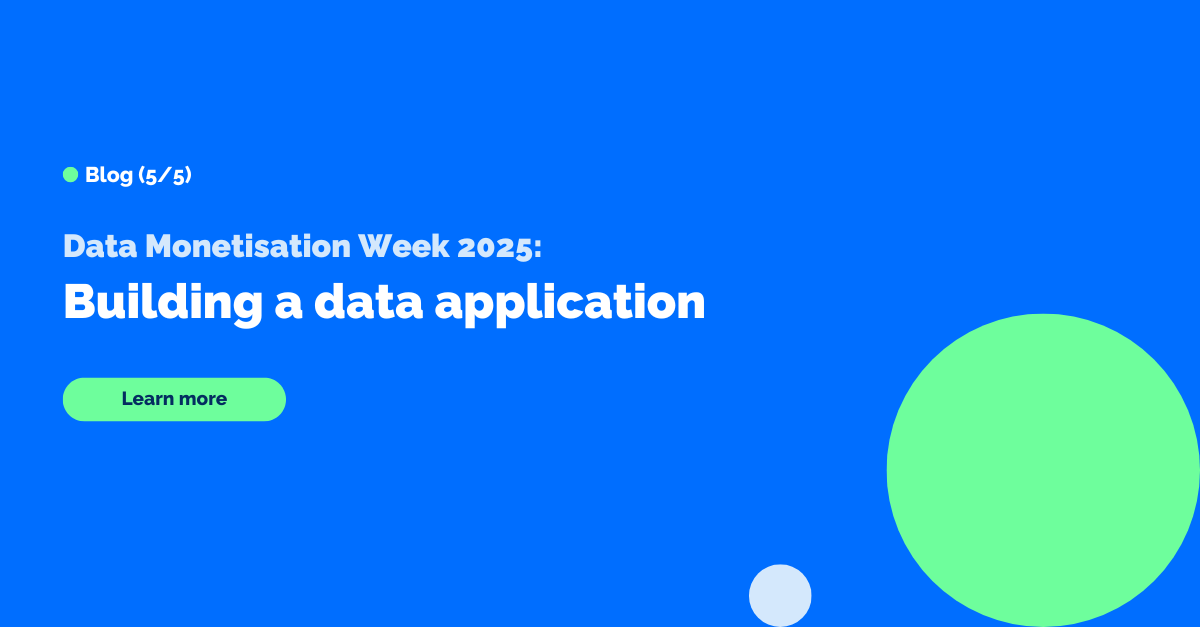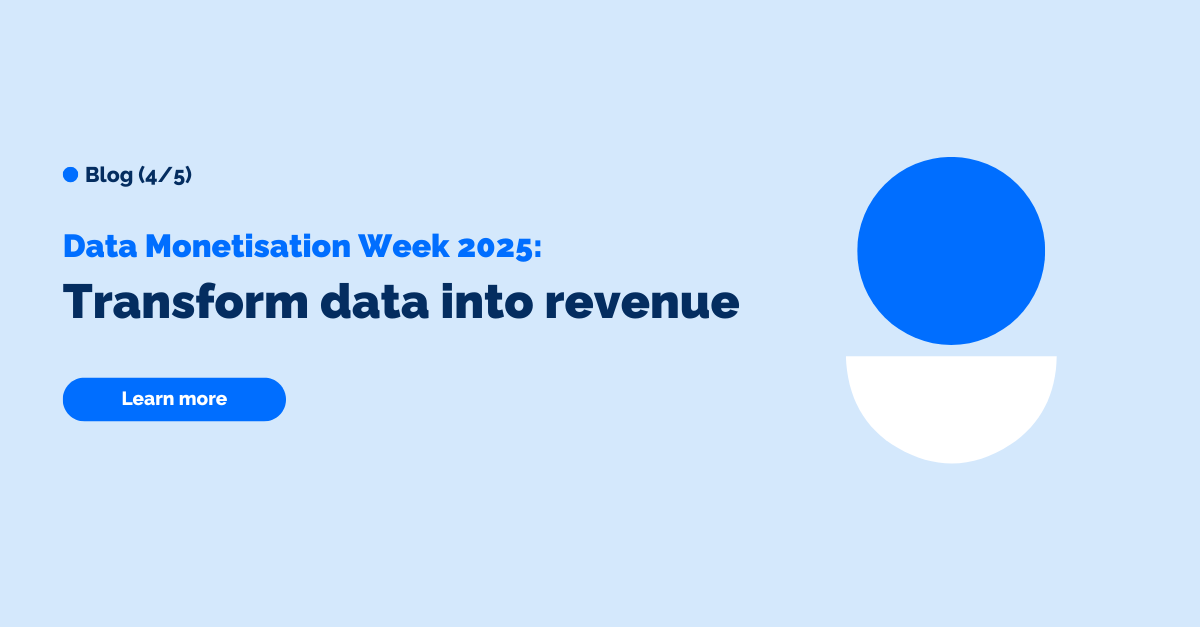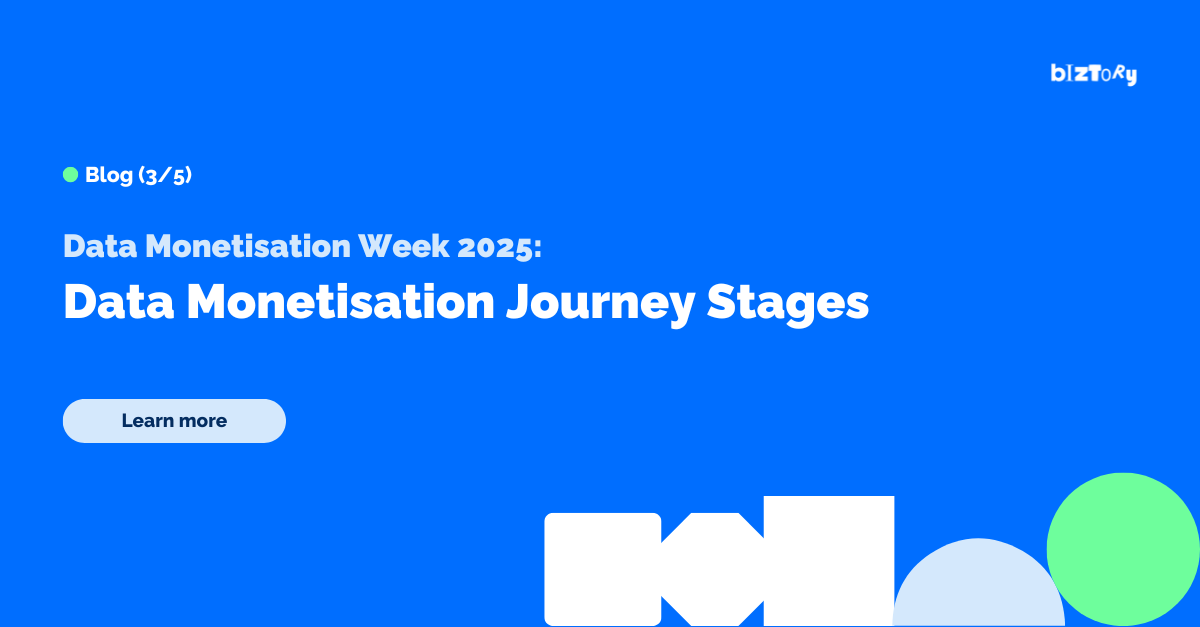As we wrap up our journey through Data Monetisation Week 2025, today marks an exciting culmination with the exploration of data apps - a tangible outcome of transforming data into actionable insights and tangible value.
Over the past four days, we have navigated through the essentials of data monetisation, the diverse models available, the stages involved in monetising data effectively, and strategies for turning data into revenue:
Day 1: What is Data Monetisation?
Day 2: Data Monetisation Models
Day 3: The 4 stages of Data Monetisation
Day 4: How to turn data into revenue
Now, on Day 5, we delve into the depths of data apps, which are instrumental in harnessing the power of data to drive decision-making and innovation. Whether these apps are internally embedded to augment existing business processes or externally embedded to enhance customer interactions, they represent the pinnacle of what it means to operationalize data for economic gain.
Grab yourself a cup of coffee. We’re getting started!
No time to read? Listen to the podcast instead.
1. What are data apps?
A data app is a type of application that primarily focuses on processing, visualising, or interacting with data to deliver insights, drive business decisions, or provide interactive user experiences. These apps can range from simple dashboards displaying business metrics to complex analytical tools that enable users to explore and manipulate large datasets.
Data apps often integrate data from various sources, utilise advanced analytics, machine learning models, and provide user-friendly interfaces to help both technical and non-technical users derive value from data.
Data apps come mainly in two different forms.
Internal vs external data apps
Hopefully, if you read through the entire 5-day blog series of Data Monetisation Week 2025, you’ll know by now that there are countless use cases for data monetisation, making it pretty difficult to categorise them. But generally speaking, there are 2 main types of data products:
Internally embedded data apps: These applications leverage embedded analytics within another existing business application. The goal is to enhance the user experience and decision-making efficiency by providing relevant data insights within the context of the application they are already using. Examples include:
- HR Platforms: Embedding analytics to track employee performance, retention rates, and hiring trends directly within HR management systems.
- ERP Systems: Incorporating analytics into enterprise resource planning systems to provide real-time insights into inventory levels, supply chain operations, or financial metrics.
- CRM Systems: Integrating analytics to offer sales forecasts, customer segmentation, and performance metrics directly within a customer relationship management system.
External data apps: extend analytics capabilities to external stakeholders such as customers, partners, or suppliers through customer-facing applications. The analytics are embedded in products or services that these external users interact with, enhancing the value and usability of the offering. Examples include:
- Customer Portals: Providing customers with access to analytics about their transactions, usage patterns, or interactions, enhancing transparency and enabling better personal management or optimization.
- Supplier Dashboards: Integrating analytics into supplier portals that allow vendors to manage inventory, track order statuses, and analyse performance metrics directly.
- Software as a Service (SaaS) Products: SaaS providers often embed analytics in their applications to offer customers insights into the data they generate while using the SaaS product, such as marketing automation tools providing campaign analytics.
Both types of embedded data apps aim to make analytics pervasive and seamlessly integrated into daily workflows, ensuring that users can access and utilise data effectively without switching between systems.
2. Why build a data app?
Companies are increasingly investing in building data apps for several strategic, operational, and competitive reasons. Here’s some of the main why building a data app can be a valuable decision for your organisation:
Better decision-making
Real-Time Insights: Data apps can provide real-time analytics, helping decision-makers respond swiftly to changes and opportunities.
Informed Decisions: By integrating data from multiple sources, companies can gain a more comprehensive understanding of their business environment.
Improved User Experience
Personalisation: Data apps enable businesses to understand customer preferences and behaviours, leading to more personalised experiences.
Customer Engagement: Interactive data apps can help keep customers informed about their transactions or interactions, increasing engagement and satisfaction.
Increased Operational Efficiency
Automation: Data apps often automate data processing and analysis tasks, reducing the workload on employees and minimising human errors.
Streamlined Processes: Integrating data analysis directly into business processes helps streamline operations and reduce delays.
Competitive Advantage:
Differentiation: Offering unique data-driven features can differentiate a company’s products and services in a crowded market.
Innovation: Data apps foster innovation by enabling new ways to use data, which can lead to the development of new products and services.
Scalability:
Handling large data volumes: As organisations grow, they generate more data, which can be efficiently managed and utilised through scalable data apps.
Flexible Integration: Data apps can be designed to scale with the business, supporting more data sources and more complex analytics as needed.
Revenue Opportunities:
Monetization: Data apps can open new revenue streams through subscription models, advertising, or by enhancing existing products with data-driven features.
Value-Added Services: Providing additional data-related services can create value for customers and generate additional revenue.
Data apps: Components
Even though data apps can vary in shape and model depending on the use case - the basic components are the same across the board.
Data sources & connectivity
Data sources are the lifelines of data apps, encompassing a broad spectrum of origins where data is gathered to fuel analytics and insights. These sources range from internal systems like databases and enterprise software (ERP, CRM) to external inputs such as third-party APIs and public datasets.
Efficiently harnessing and integrating these varied data sources—whether structured or unstructured—is key to building a robust data application that can serve comprehensive, actionable insights.
Data Storage
Data storage in data apps is designed to accommodate the diverse and voluminous data captured from various sources. Relational databases are traditionally used for structured data requiring strict consistency, while NoSQL databases cater to flexible schema needs and scalability across document, key-value, wide-column, and graph-based data.
Data warehouses like Snowflake offer optimised environments for complex queries and analytics on large data sets, ideal for strategic decision-making. Data lakes, often utilised in big data environments, store vast amounts of raw data in their native format, allowing for flexible processing and analysis as needs evolve. Cloud storage solutions further enhance scalability and accessibility, providing a backbone for data apps that need to adapt to varying demands and scales efficiently.
Data Processing & Modeling
Data processing enables the transformation of raw data into valuable insights - which is what most data apps are all about.
This process begins with the extraction of data from various sources, followed by its transformation to fit analytical needs, and concludes with loading into a suitable storage system—commonly referred to as the ETL (Extract, Transform, Load) process.
Data modelling involves designing data structures and relationships to efficiently store, retrieve, and manipulate data. This step is foundational in creating a scalable and performant backend for data apps, ensuring that data is organised logically and efficiently.
Analytics & Visualisation
Analytics within data apps serve as the critical component for deriving actionable insights from raw data. Effective analytics can highlight trends, predict future events, and offer recommendations based on historical data.
Machine learning models are often at the core of these analytics, adapting and improving over time as they are exposed to more data. Advanced techniques, such as deep learning, are used for more complex scenarios like image recognition or natural language understanding. The integration of AI not only automates data interpretation but also provides a level of insight that can dynamically adapt to changing business environments.
The sophistication of the analytics directly impacts the effectiveness of data apps in delivering precise and predictive insights, thereby enhancing decision-making across the organisation.
Visualisation is the interface through which data insights are communicated to users, making it a vital aspect of data apps. It translates complex data sets into graphical representations such as charts, graphs, maps, and dashboards, which allow users to quickly grasp difficult concepts or identify new patterns. Effective visualisation requires not only graphical excellence but also interactivity, enabling users to manipulate data or drill down into metrics for more detailed views.
User Interface (UI)
The user interface (UI) is the front-end component of data apps where user interaction occurs, and it plays a crucial role in user experience (UX). A well-designed UI should be intuitive, responsive, and accessible, allowing users to navigate and use the app’s features with ease. This includes the layout of elements, colour schemes, font choices, and interactive components that make the app engaging and easy to use.
The UI must effectively bridge the gap between the complex data processing back-end and the user, making advanced analytics accessible and understandable to a non-technical audience. A successful UI design enhances user engagement and satisfaction, directly influencing the adoption and success of the data app.
Data apps: build vs buy
When looking to launch a data application or product, the question always arises: do you build it yourself from scratch? Or do you leverage a pre-built solution where you might lose some flexibility - but probably lots of headaches too?
There are several key considerations that come into play here. Each option offers distinct advantages and potential drawbacks, so the right choice will really depend on the specific needs, resources, and strategic goals of your organisation and use case.
Costs:
Building a custom app usually requires a higher initial investment in terms of time and resources. Over time, maintaining and updating a custom app can be costly too, but it also allows for more controlled scaling to accommodate growth or changing needs.
Off-the-shelf solutions have lower upfront costs and can be deployed more quickly than building a custom solution from scratch. It’s also a lot more predictable. Costs related to upgrades, support, and maintenance are often included in the subscription, making budgeting easier.
Scalability & flexibility:
While some pre-built solutions offer customization options, they may not meet all specific needs or integrate perfectly with other systems. There is also the risk of vendor lock-in, where future pricing or changes in product direction could adversely impact users.
Building a custom app allows for tailoring the features, user experience, and performance to exactly match the organisation's unique requirements.
Reliability:
Pre-built solutions have typically been tested extensively and used by other organisations, which can provide assurance of their reliability and performance. Established vendors provide ongoing support, regular updates, and enhancements, which can alleviate the burden on your internal IT staff.
That ease of mind can be worth a lot too.




